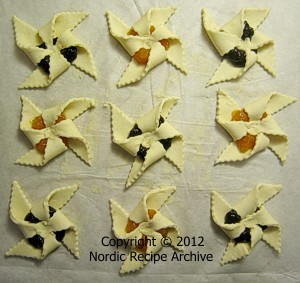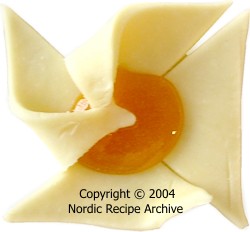
|
|||||||||||||||||||||||||||
| MAIN RECIPE PAGE |
|
||||||||||||||||||||||||||
|
STAR-SHAPED CHRISTMAS PASTRIES
Ready-made plum and apricot jams and marmalades especially intended to be used as filling in these pastries can be found sold in Finnish stores, but the homemade jams have a slightly better taste. Plum filling is the more traditional choice, but some prefer apricot with its tarter flavour. about 250 g butterplum filling: 100 ml (about 100 g) pitted prunesapricot filling: 100 ml (about 100 g) dried apricots
Place the thoroughly rinsed prunes or apricots in a small saucepan. Prick the fruit with a fork or a toothpick (or cut the fruit in smaller pieces with scissors). Pour over the sugar and water. Bring the mixture to the boil, then lower the heat. Cover the pan and let the mixture simmer very gently and slowly, until the fruit have thoroughly softened, about 15 to 20 minutes. Note that the thicker-skinned apricots may take longer to soften or require slightly more liquid to cook than the prunes. Stir every now and then to prevent the mixture from sticking or burning to the pan. Depending on the moisture content of the type of dried fruit used, the amount of liquid left in the pan may vary. However, most of it should be absorbed in the fruit by the end of cooking. Further lower the heat during cooking, or add a dash of water, if the liquid seems to evaporate before the fruit has thoroughly softened.
You can flavour the plum mixture with a dash of powdered cinnamon and vanilla sugar or extract, and the apricot mixture with a dash of lemon juice and a few drops of almond extract. Spoon the hot jam in clean jars, sterilized with boiling hot water. Cover tightly with sterilized lids and store in refrigerator. However, if you plan to use the jam within a few days, it will keep stored in clean bowls or jars, covered with plastic wrap. Any leftover filling may be served as marmalade spread on toast, muffins, etc, or used as filling in layer cakes, Swiss rolls, pastries, etc.
Preparing the pastry dough: Bring the butter to room temperature. Open the quark package/tub — if there is visible liquid separated from the quark in the package, gently pour it out. Weigh the quark after transferring it into a bowl, then adjust the weights of butter and flour to match that of the quark, ie the ratio of the ingredients should be 1:1:1. Mix the quark with a fork until smooth. Blend the softened butter thoroughly with the quark by hand. You can use a fork, a spoon or your clean hands. Add the flour, stirring gently by hand. Mix just enough to get the ingredients blended. Shape the dough into a flat square, wrap it in plastic wrap and place in refrigerator to harden.
Forming the pastries:
At this stage, you can fold the dough into three layers similarly to puff pastry and roll it out again, then repeat the folding and rolling once more, as this will produce pastries with a flakier texture (see the picture on right). Peel off the upper parchment paper carefully. Trim the edges of the dough and cut it with a pastry wheel into equal-sized squares, about 8 × 8 cm in size (see figure 1 below).
Cut the corners of each little square the way it is shown in figure 2 above.
Place approximately 1 tablespoon (or less) of plum or apricot filling in the middle of each square (figure 3). Fold every second tip of the slit corners towards the centre to form a pinwheel-shape and press the tips together firmly (figures 4 and 5).
Take the second part of the dough and the leftover pieces and repeat the rolling and cutting process. If the dough warms up and gets too sticky to handle, place it in refrigerator for a while. Details on forming and filling a single Christmas pastry:
Baking the pastries:
Let the pastries cool down a bit on a wire rack and, if preferred, sift some icing sugar on them just before serving (see the picture on right). Serve the pastries accompanied by glögg, or with tea or coffee. In picture on right: Christmas pastry dusted with icing sugar. You may use puff pastry (pâte feuilletée) instead of the quark-butter dough.
In picture on right: Christmas pastries made with quark-butter dough, filled with apricot and plum marmalade. Makes about 18 - 25 pastries. Serving suggestion: |
|||||||||||||||||||||||||||
|
 These pastries are made of a dough consisting of
These pastries are made of a dough consisting of  Preparing the filling(s):
Preparing the filling(s): Puree the mixture with a hand blender — be careful not to burn yourself, as the hot mixture may splash. If you like an even smoother puree, rub it through a fine sieve.
You can also use a
Puree the mixture with a hand blender — be careful not to burn yourself, as the hot mixture may splash. If you like an even smoother puree, rub it through a fine sieve.
You can also use a  Dust a parchment paper lightly with flour, place the other half of dough on it, dust it lightly with flour
and top with another parchment paper. Roll out the dough into a square approximately 5 mm thick.
Dust a parchment paper lightly with flour, place the other half of dough on it, dust it lightly with flour
and top with another parchment paper. Roll out the dough into a square approximately 5 mm thick.









 Brush the top surface of the pastries lightly with egg yolk and bake for about 10 - 15 minutes or until they are golden brown and slightly puffed.
Brush the top surface of the pastries lightly with egg yolk and bake for about 10 - 15 minutes or until they are golden brown and slightly puffed.
 The former makes puffier and flakier pastries — and this is the way they are usually done — the latter flatter and not as attractive, but much tastier, in my opinion :-)
The former makes puffier and flakier pastries — and this is the way they are usually done — the latter flatter and not as attractive, but much tastier, in my opinion :-)